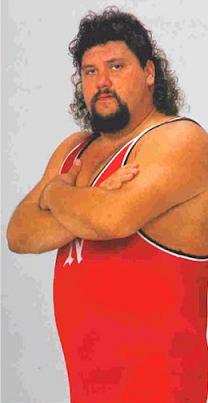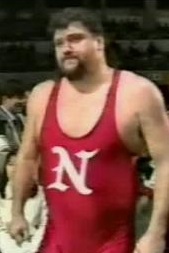Gary Albright facts for kids
Quick facts for kids Gary Albright |
|
|---|---|
 |
|
| Birth name | Gary Mitchell Albright |
| Born | May 18, 1963 North Kingstown, Rhode Island, U.S. |
| Died | January 7, 2000 (aged 36) Hazleton, Pennsylvania, U.S. |
| Cause of death | Heart attack |
| Alma mater | University of Nebraska |
| Spouse(s) | Monica Anoaʻi |
| Children | 3 |
| Family | Anoaʻi (by marriage) |
| Professional wrestling career | |
| Ring name(s) | Gary Albright Vokhan Singh |
| Billed height | 6 ft 4 in (193 cm) |
| Billed weight | 353 lb (160 kg) |
| Billed from | Billings, Montana, U.S. (as Gary Albright) Karachi, Pakistan (as Vokhan Singh) |
| Trained by | Billy Robinson Danny Hodge Lou Thesz |
| Debut | 1988 |
| Medal record | ||
|---|---|---|
| Collegiate Wrestling | ||
| Representing the Nebraska Cornhuskers | ||
| NCAA Division I Wrestling Championships | ||
| Silver | 1984 East Rutherford | Heavyweight |
| Bronze | 1986 Iowa City | Heavyweight |
Gary Mitchell Albright (born May 18, 1963 – died January 7, 2000) was an American professional wrestler. He was very well known for his wrestling in Japan. He wrestled for UWF International (UWFi) and later All Japan Pro Wrestling (AJPW). In AJPW, Albright won the World Tag Team Championship two times. He also wrestled in Canada for Stampede Wrestling. There, he used his real name and also the ring name Vokhan Singh.
Gary Albright was a talented amateur wrestler. He used many powerful suplexes and throws in his professional wrestling matches. This earned him the nickname "Master of Suplex."
Through marriage, Albright became part of the famous Anoaʻi wrestling family. His wife, Monica, is the daughter of Afa Anoaʻi.
On January 7, 2000, Gary Albright collapsed during a wrestling match. He was pronounced dead shortly after leaving the ring. Doctors later said he died from a heart attack.
Contents
Gary Albright's Amateur Wrestling Career
Gary Albright was born in Rhode Island. He started amateur wrestling when he was in high school. He wrestled for Billings West High School in Billings, Montana. He had an amazing record of 55 wins and only 2 losses there. In 1980, Albright became the Montana state champion. The next year, he placed second in the state championships.
Albright then wrestled for the University of Nebraska. He set a record for the most "falls" (when you pin your opponent) in a season. He had 38 falls during the 1985-1986 season.
Here are some of Gary Albright's top achievements in amateur wrestling:
- He was the Montana State Champion in 1980.
- He had 58 wins, 4 losses, and 3 draws at the University of Nebraska.
- He was a Big 8 Champion.
- He was part of the Big 8 All-Academic team.
- He was an NCAA Runner-up.
- He competed in Freestyle and Greco-Roman wrestling.
- He was a member of the U.S. team from 1981 to 1984.
- He won the National Open Freestyle championship in 1982.
- He was the World Greco-Roman Elite champion in 1981.
- He was a member of the "Sunkist Kids" national championship team.
Gary Albright's Professional Wrestling Journey
Starting in Stampede Wrestling (1988–1989)
After college, Gary Albright began training to become a professional wrestler. Famous wrestlers like Lou Thesz, Billy Robinson, and Danny Hodge helped him. In 1988, Albright joined Stu Hart's Stampede Wrestling in Calgary, Alberta, Canada. Brian Pillman helped him get noticed by the Hart family.
Albright first started as a good guy, known as a face. But soon, the promoters decided he would be better as a bad guy, called a heel. His character was changed to "Vokhan Singh," and he was said to be from Karachi, Pakistan. Albright teamed up with Makhan Singh to form a team called Karachi Vice. Their leader was Gama Singh.
The two large wrestlers, Albright and Shaw, were a very strong team. They won the Stampede International Tag Team Championship from the British Bulldogs on December 30, 1988. They held the titles for about four months. They lost them to Chris Benoit and Biff Wellington on April 8, 1989. Stampede Wrestling closed later that year, and Albright looked for new places to wrestle.
Wrestling Around the World (1989–1991)
After Stampede Wrestling, Albright wrestled in different places. He went on tours in South Africa. He also appeared in USWA, WCW, and New Japan Pro-Wrestling. He wrestled for various smaller wrestling groups between 1989 and 1991.
Success in UWF International (1991–1995)
Bruce Hart helped Gary Albright join a new wrestling group called Union of Wrestling Forces International (UWFi). UWFi was known for its "shoot style" wrestling. This meant the matches looked very real, with strong strikes, suplexes, and submission holds. However, like all professional wrestling, the winners were decided beforehand.
Albright's first match in UWFi was on August 24, 1991. He quickly knocked out Yoji Anjoh. Because of his large size and amateur wrestling skills, his suplexes looked incredibly powerful. He often won matches by knocking out his opponents with brutal German suplexes. For example, he knocked out Kiyoshi Tamura in just over five minutes.
A big moment for Albright in UWFi was on May 8, 1992. He knocked out Nobuhiko Takada with his German suplex in front of 14,000 fans. Takada was UWFi's biggest Japanese star. This win helped show that Albright was a very serious competitor. Albright kept winning matches through the summer of 1992. He beat famous wrestlers like "Bad News" Brown. His winning streak ended when he lost a rematch to Takada on September 21, 1992. Takada made Albright give up using a cross arm breaker. This made Takada the first UWFi World champion.
After this loss, Albright continued to win many single matches, usually very quickly. But when Super Vader joined, Gary Albright was no longer the top foreign wrestler, called a "gaijin." He started wrestling in earlier matches instead of the main events.
In 1994, Albright started getting more attention again. This was during UWFi's "Best of the World" tournament. He knocked out Billy Scott in the first round. Then he beat Yoji Anjoh to reach the semifinals against Nobuhiko Takada. On June 10, 1994, Albright lost to Takada in the main event. Albright finished third in the tournament by defeating Kiyoshi Tamura on August 18, 1994. That same night, Vader beat Takada for the UWFi title.
UWFi then planned a "Dream Match" between Vader and Albright. They had a few tag team matches to build excitement for the big singles match. On October 8, 1994, Albright made Vader give up in a tag team match. Then, on November 30, 1994, Albright made Takada give up. This earned him the match with Vader in January. The "Dream Match" happened on January 16, 1995. Vader won the match. These matches with Vader and Takada were very popular and drew large crowds.
By 1995, UWFi started having problems. They had focused on Albright, Takada, and Vader, but they hadn't created enough new challengers. Their audience numbers were going down. On May 17, 1995, Albright lost to Masahito Kakihara. On June 18, 1995, Albright wrestled Kiyoshi Tamura. Albright returned two months later and lost to Tamura again. Six days later, UWFi announced they would work with New Japan Pro-Wrestling. Albright then left UWFi and signed with All Japan Pro Wrestling.
Becoming a Tag Team Champion in All Japan Pro Wrestling (1995–1999)
On October 25, 1995, Gary Albright lost to Toshiaki Kawada in Japan. Albright then teamed up with Stan Hansen. They finished third in the World's Strongest Tag Determination League. On January 24, 1996, Albright and Hansen beat Kawada and Taue to win the World Tag Team Championship. But they lost the titles back to Kawada and Taue four weeks later. Albright challenged Mitsuharu Misawa for the Triple Crown Heavyweight Championship on March 2, 1996. Misawa won that match, keeping his title. This was Albright's only chance at AJPW's main championship.
Albright had a less successful year in 1996. He teamed with Sabu in the 1996 World's Strongest Tag Determination League. They finished last in the tournament.
Albright's time in AJPW became very successful when he teamed with "Dr. Death" Steve Williams and Lacrosse in early 1997. They formed a group called the "Triangle of Power." Albright and Williams finished third in the World's Strongest Tag Determination League that year. Before that, they won the World Tag Team Championship titles on July 25, 1997. Albright found his greatest success in AJPW teaming with Williams. They were a very strong team, beating top wrestlers like Mitsuharu Misawa and Jun Akiyama.
Albright became the leader of the Triangle of Power after Williams left in June 1998. Albright's new teammates were Yoshihiro Takayama and Masahito Kakihara. Even though he had been very successful, Albright found himself wrestling in the middle of the show again. His new group was not pushed as strongly. In 1998, Albright teamed with Giant Kimala. They won only one match on TV, but they often won matches at smaller live shows.
In 1999, Albright wrestled against wrestlers like Bart Gunn, Johnny Ace, Stan Hansen, and Big Van Vader. He won some tag team matches against them on TV. However, in the fall of 1999, Albright started losing more matches on AJPW TV. Most of his wins were against less experienced wrestlers. Albright teamed with Wolf Hawkfield (the renamed Lacrosse) to finish last in the 1999 Tag League.
Albright won his final match in All Japan on December 3, 1999. He beat Masao Inoue.
One Match in Extreme Championship Wrestling (1996)
Albright wrestled one match for Extreme Championship Wrestling (ECW) in Philadelphia, Pennsylvania, in December 1996. He quickly defeated Rick Rage at an event called Holiday Hell.
Gary Albright's Passing
On January 7, 2000, Gary Albright was wrestling at a World Xtreme Wrestling show in Hazleton, Pennsylvania. He was wrestling against Lucifer Grimm. After receiving a move called a cutter, Albright collapsed in the ring. Other wrestlers and ring crew quickly tried to help him. Albright was pronounced dead shortly after being taken out of the ring.
The official cause of death was a heart attack. Doctors also found that Albright had diabetes, an enlarged heart, and blockages in some of his heart arteries. Since it was determined he died of natural causes, the police were not involved.
Gary Albright was survived by his wife, Monica Anoaʻi, his son Samuel, and two daughters, Angelica and Alexandria.
A special event called the Gary Albright Memorial Show was held three months after his death. It was put on by WXW, the World Wrestling Federation, and All Japan Pro Wrestling to honor him. His close friend and fellow Anoaʻi family member, The Rock, opened the show by remembering and paying tribute to Albright.
Championships and Achievements
- All Japan Pro Wrestling
- World Tag Team Championship (2 times) - with Stan Hansen (1 time) and "Dr. Death" Steve Williams (1 time)
- George Tragos/Lou Thesz Professional Wrestling Hall of Fame
- Class of 2023
- Pro Wrestling Illustrated
- PWI ranked him #74 of the 500 best singles wrestlers in the PWI 500 in 1995
- PWI ranked him #259 of the 500 best singles wrestlers during the PWI Years in 2003
- Stampede Wrestling
- Stampede International Tag Team Championship (1 time) - with Makhan Singh
- Wrestling Observer Newsletter
- Rookie of the Year (1988)
See also
- List of premature professional wrestling deaths


